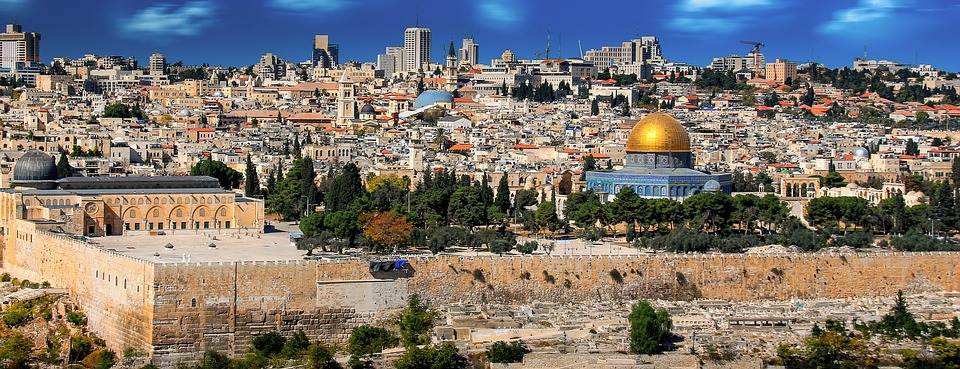Jerusalem
Jerusalem was the land of Jebusites, the descendants of Ham, the son of Noah (Genesis 10:16). The term Jerusalem was mentioned as the land of Jebus in Judges 19:10. According to 1 Chronicles 11:4-5, King David captured Jerusalem and made it his capital city, known as the city of David (c.1000 BC), and since then, Jerusalem remained as the capital city of Israel. After the partition of the kingdom into Israel and Judah, Jerusalem became the capital of Judah and Samaria became new the capital of Israel. According to 2 Kings 17:21-24, the nation of Israel was defeated, captured and resettled by the Assyrians (722 BC). Despite God’s judgement upon Israel and the threat from the Assyrian king Sennacherib during the reign of king Hezekiah, God delivered Judah from the Assyrian threat by sending an angel who killed around 185,000 men of the Assyrian army in one night (2 Kings 18:17; 19:14-19; 35-36; Isaiah 37:36-38). In spite of this, Judah continued to sin against God. Finally, God raised the Babylonians against them. They captured and broke into the city and destroyed the temple completely by setting it on fire (2 Kings 25:1-12). Thus, the capital city of Jerusalem and the magnificent temple were destroyed in 586 BC by the Babylonians.
Ever since the founding of Jerusalem as the capital of Israel, the city became the center of God’s work. Every time, the enemy tried to destroy the city, God defended the city and His people but conflicts still arise. Although the United Nations came up with the plan of dividing Palestine into Jewish and Arab states in 1947, the Arabs did not support this plan. Despite the age-old oppositions and struggles for freedom, with the approval of the United Nations, David Ben-Gurion, the head of the World Zionist Organization and the chairman of the Jewish Agency, proclaimed Israel as an Independent country on 14 May, 1948. Thereafter, the Jews claimed the city, but the Muslim world is not ready to give-up on either the city or the Islamic shrine they constructed in the seventh century AD. The Islamic world and many others around the world put forth their recommendation of overcoming this crisis by keeping Jerusalem just as the way it is now – a multi-religious, multi-cultural, multi-political, and multi-linguistic city that belongs to both groups equally. In the midst of all these struggles, God has His own plan to resolve crises related to the Jews, the city of Jerusalem, and the temple. Ultimately, God will bring down the New Jerusalem from heaven and establish His everlasting throne at the center of the city. Psalm 122:6 says, Pray for the peace of Jerusalem.
The Temple of Jerusalem
- King David had a desire to build a temple for God (Reference: 2 Samuel 7:1-17; 1Chronicles 22:6-10; 28:1-21; Psalm 132:1-5)
- The first Temple was built by king Solomon, son of king David, in c. 957 BC (Reference: 1Kings 6:1-14 [1Kings 5:1-6:38 & 7:13-51]; 2 Chronicles 3:1-17; 7:1-2)
- The Temple was destroyed and burned down by the Babylonians during the reign of Nebuchadnezzar in 586 BC (Reference: 2 Kings 25:1-12; 2Chronicles 36:15-21; Jeremiah 52:12-14)
- After the remnant of Israel returned from captivity, the construction of a new temple began in 536 BC under the leadership of Zerubbabel (the Governor of Judah) and Joshua (the high priest). This reconstruction was, however, halted due to the Samaritan opposition. After about 16 years, God spoke through His servants, Haggai and Zechariah, to restart the rebuilding of the temple. The construction work restarted in 520 BC and the temple was completed and dedicated in 516 BC (Reference: Ezra 5:2; 6:3-5, 13-15; Zechariah 4:9)
- Many years later, a Greek ruler, named Antiochus Epiphanes, offered a pig sacrifice on the altar (Daniel 11:31) and defiled it as part of his universal Hellenization project in 167 BC
- Following that, an ardent Jew named Judas Maccabeus (known as – the Hammer) regained power and recaptured the temple from the Greek ruler, purified the temple and rededicated it in 165 BC. This event is celebrated as Hanukkah in commemoration of the purification and rededication of the temple. It is also called festival of dedication or the festival of lights.
- Herod the Great renovated the temple in 20 BC and called it as Herod’s Temple. But, in line with the prophecy of Christ (Reference: Matthew 24:1-2; Mark 13:1-2; Luke 21:5-6), the Romans destroyed the temple completely in AD 70
- Later, the Roman Emperor Julian authorized the rebuilding of the Temple. However, while the rebuilding was in progress, a severe earthquake devastated Galilee and the surrounding regions in 4th century AD. This stopped the rebuilding of the Temple and the people eventually gave up rebuilding the Temple.
- In 7th century AD, the Muslims captured the city and constructed an Islamic shrine on the site of the Temple
- The United Nations introduced a plan of dividing Palestine as Jewish and Arab states (1947), however the Arabs did not support the plan. Nonetheless, Israel was officially given their independence from the British Colonial Mandate on the May 14, 1948.
- Now, the Jews reclaim it as their own city, but the Muslim world is not ready to withdraw from the city or the shrine. Hence, the conflict continues. The Islamic world and many others around the world put forth their recommendation of keeping Jerusalem just as the way it is now – a multi-religious, multi-cultural, multi-political, and multi-linguistic city that belongs to both groups equally. However, in the end, the will of God will prevail above the will of any man or people.
- We are asked to pray for the peace of Jerusalem (Psalm 122:6)

